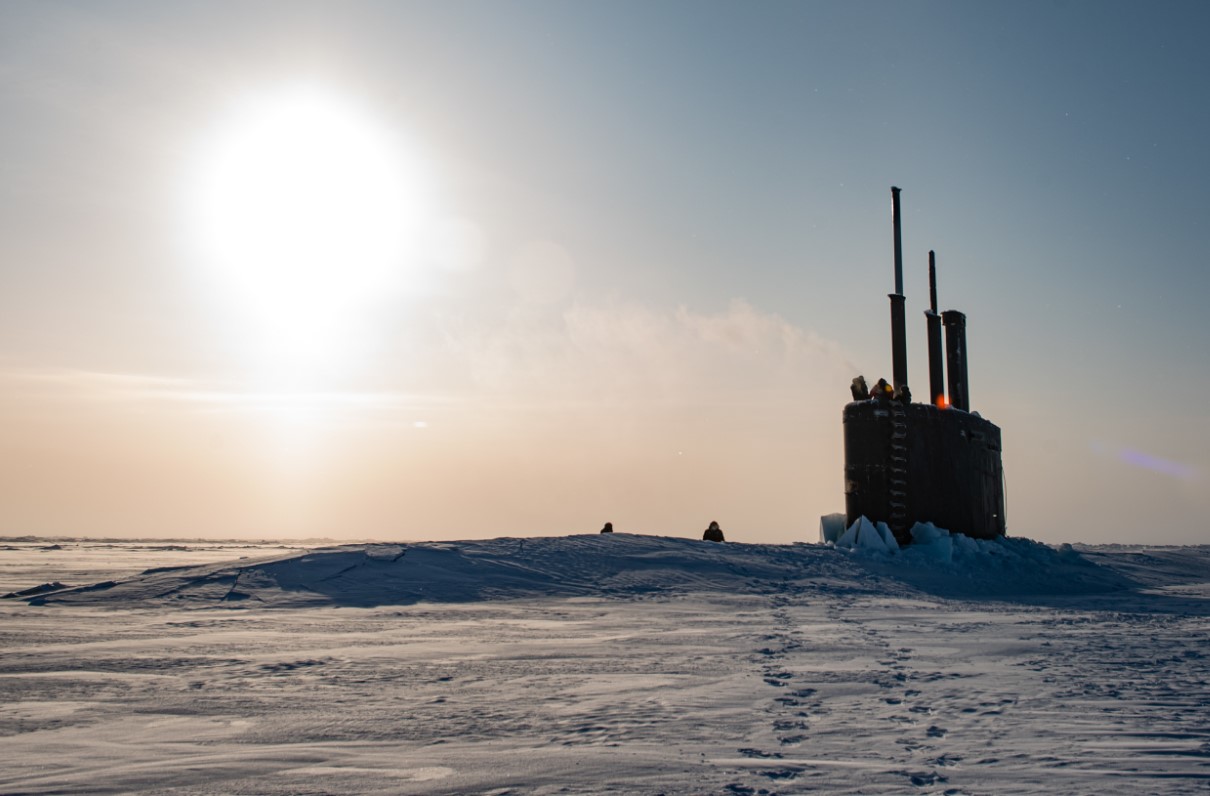(This article by Christopher P. Cavas originally appeared in the February 2022 issue of Military Officer, a magazine available to all MOAA Premium and Life members. Learn more about the magazine here; learn more about joining MOAA here.)
The most lethal strike fighter fleet in the U.S. has been growing, bit by bit, at the rate of about two per month.
Air Force F-35A Lightning II Joint Strike Fighters have been headed north since April 2020, often straight from the Lockheed Martin factory that built them in Fort Worth, Texas. Their destination: Eielson Air Force Base in Alaska, home of the 354th Fighter Wing.
In early 2022, a total of 54 Lightning IIs will call Alaska their home. Together with a similar number of F-22A Raptors, there will be more than 100 combat-coded fifth-generation fighters in the state, the most anywhere in the U.S.
The arrival of the JSF in the far north is an example of the increased level of attention being paid to the Arctic as the gradual warming of the region opens the area up to economic development and competition.
This means more access to raw minerals like nickel, copper and platinum, oil, and natural gas. Longer ice-free periods of navigation in shipping routes through previously frozen waters mean more access to rich fishing waters and increased tourism, resulting in more countries and industries looking to exploit the region.
And as competition increases, the potential for conflict is an ever-present byproduct.
“Our adversaries are increasing their activity in the region in part through the enabling factor of their own climate changes,” said Michael McEleney, senior advisor to the Department of Energy’s Arctic Energy Office and a former Arctic analyst for the Navy. “Longer shipping seasons, greater investment in resource extraction to accelerate their resource extraction efforts. All of it is turning the Arctic into a much more dynamic region for the U.S. government to take into account.”
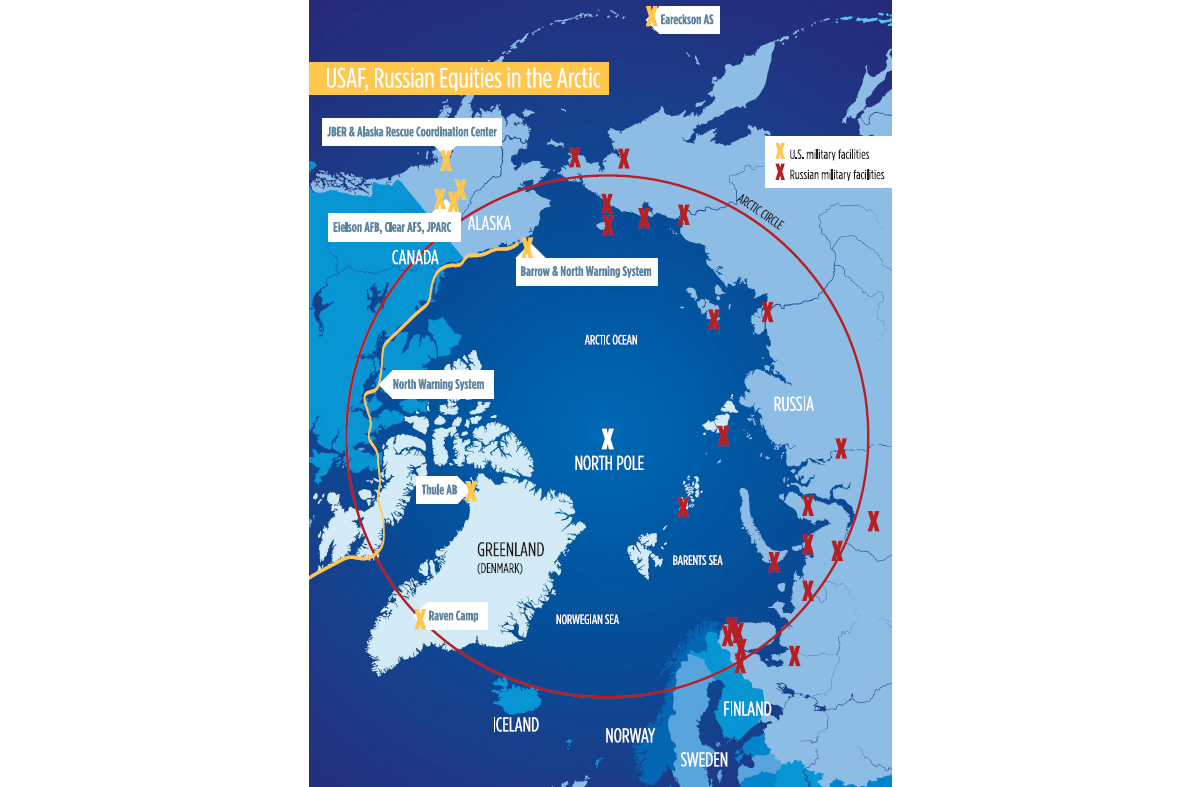
A view from above of the Arctic Circle. (Department of the Air Force Arctic Strategy; Rachel Barth/MOAA Staff; click here for larger image)
Those are just some of the reasons there seems to be constant discussion about the Arctic. Barely a week goes by without a new strategy, study, or position paper being released. Defense groups, military services, academic organizations, environmental and economic entities hold streams of conferences focusing entirely or in part on the region. “What are we doing in the Arctic?” is a routine question raised by senators and congressional representatives in multiple hearings in Washington, D.C. But the answers are rarely simple enough for a quick sound bite.
“It’s a complex story at the top of the world today, made more complex by global media, because to them it’s all about tension, resource wars, whether we go to war with the Russians or Chinese at the top of the world,” said Capt. Lawson Brigham, USCG (Ret), distinguished professor of geography and Arctic policy at the University of Alaska Fairbanks and a former Coast Guard icebreaker captain.
“There isn’t a single message,” he said. “This place is peaceful. It’s stable, and it’s cooperative.”
A recent example of that cooperation was the October 2020 adoption by the Arctic Council of an international agreement to prevent unregulated fishing in the high seas of the Central Arctic Ocean. The agreement pledges each signatory nation to not allow its vessels to engage in commercial fishing in the ocean, which is surrounded entirely by the economic exclusion zones (EEZs) of the council’s member states.
The center of international relationships in the far north is the Arctic Council, an independent entity whose eight permanent members are those with sovereign territory within the Arctic Circle: Canada, Denmark (by virtue of Greenland), Finland, Iceland, Norway, Russia, Sweden, and the U.S., along with Arctic indigenous peoples.
Thirteen nations take part as observer members, with no voting rights: Germany, the Netherlands, Poland, the United Kingdom, France, Spain, China, India, Italy, Japan, South Korea, Singapore, and Switzerland. Applications are pending for the European Union and Turkey.
Established in 1996, the council has been a key entity in managing the region as development and changes continue in the region.
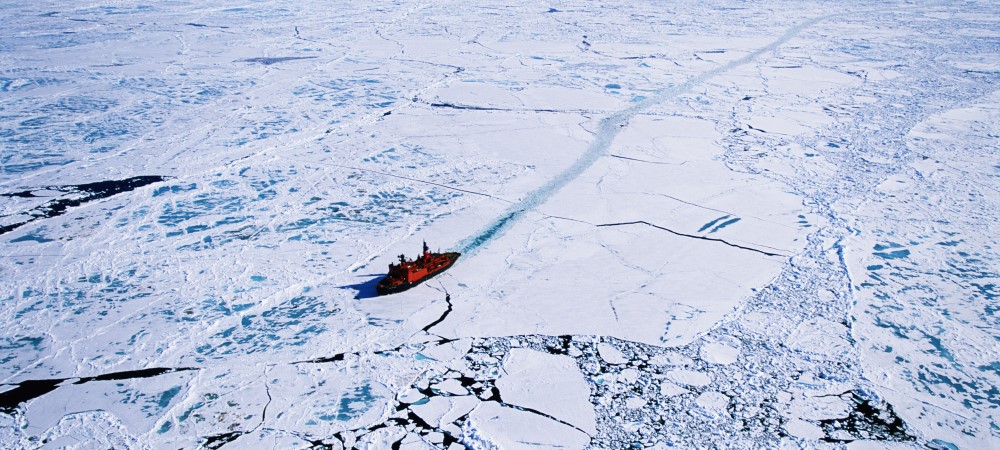
A Russian nuclear-powered icebreaker operates in the Arctic region. (Per Breiehagen/Getty Images)
‘An Entirely New Coast’
At the forefront of development are the Russians — unsurprisingly, given their vast, 15,000-milelong Arctic coastline, by far the longest continuous coastline of any single country. Stretching from the border with Norway, the Russian Arctic coast continues to the northwest Pacific, where it meets North Korea and nears the Japanese home islands.
More than 4 million people live above the Arctic Circle, and more than half of them live in Russia.
“From a Russian perspective, they’re having an entirely new coast” due to Arctic warming, noted McEleney. “That is a dramatic change in their perceived security environment. Imagine adding a new coast in an area where their defenses have run down after the Cold War. Their rush to increase the surveillance and military coverage of their Arctic coast is driven in part by climate change. By effectively having a new ocean in their backyard, they feel the need to guard against other activity, whether merited or not.”
Russian efforts to develop new infrastructure include construction of a deep-water port at Sabetta on the Yamal Peninsula in western Siberia. The multinationally funded work, which began in 2012, features a new liquified natural gas (LNG) production facility with deep-draft channels dredged by a Belgian firm. The port is being built with Chinese-made modules carried aboard Chinese-built heavy-lift ice-capable vessels operated by the Dutch company Red Box Energy Services.
Over the past several years, a large fleet of 15 80,000-deadweight-ton, ice-breaking LNG tankers has been built in South Korea designed by a Finnish firm. One of those ships is owned in Russia, but the other 14 are owned elsewhere, including Japan, China, and two multinational corporations. And while Russia has contributed 50.1% of the funding for the Sabetta project, the rest comes from France and China.
Russia is also developing and reactivating an entire security structure to protect Arctic coast investments. New icebreakers are being added to the existing fleet of about 50 ships, including some of the world’s largest and most powerful icebreakers, six of them nuclear-powered. The Russian navy is building Project 23550-class icebreaking patrol ships, 8,500-ton ships of which the first, Ivan Papanin, is expected to enter service in 2023.
The Russian military has also reactivated and upgraded a number of facilities shut down after the end of the Cold War.

Members of the Alaska National Guard participate in exercise Arctic Eagle 2020. (Photo by Spc. Kyle Odum/Alaska National Guard)
U.S. Military Strategies
By contrast, the U.S. has about 1,500 nautical miles of Arctic coastline, all in Alaska, and there is no deep draft port north of the Arctic Circle. Brigham has long supported development of Nome, Alaska, as a deep-water port, and some money is coming for the Army’s Corps of Engineers to dredge the small harbor to a depth of 35 feet and construct an improved breakwater. But even then, the land infrastructure — roads and railroads — would need to be developed to take advantage of the port. That would require much more money, and the concept faces stiff opposition from those opposed to such development.
“The question,” Brigham said, “is if the regional Arctic deep-water port is a high priority item for the Defense Department in the mix of other issues.”
While every U.S. military service has issued some sort of Arctic strategy, each service has different features. Here’s a quick breakdown:
Navy
In recent years, the Navy has made several forays above the Arctic Circle, the first such operational cruises by surface ships since the last century. The cruises have become more frequent as the Navy seeks to restore experience operating in rough, freezing northern waters.
The focus of the Navy’s Arctic efforts, though, is not surface ships — it is submarines. Ever since the famous undersea voyage of the USS Nautilus to the North Pole in 1958, U.S. subs have routinely used the Arctic for a variety of purposes, not the least of which is that the voyage across the top of Canada is a shorter way for subs to transit between the Atlantic and Pacific theaters.
The public highlight of U.S. Arctic submarine operations is the Ice Exercise, or ICEX, held every other year. Usually featuring two subs that surface through the ice cap, sailors and scientists set up a temporary ice camp — Camp Seadragon — and for three weeks conduct scientific experiments and surveys. The exercise also provides VIPs with the chance to venture to the far north and see the challenging conditions there, as well as glimpse some of the changes.
But ICEX also has an operational side.
“What we want to do is make sure, one, that we maintain access to the Arctic and sustain our readiness of the submarine forces to traverse underneath the ice,” Rear Adm. Leonard “Butch” Dollaga, then commander of the Undersea Warfighting Development Center, said during ICEX in March 2020.

A sailor aboard the submarine USS Hartford (SSN-768) during ICEX 2018 (Photo by MC2 Michael H. Lee/Navy)
“We want to make sure we can continue to gain access to the Arctic as it becomes more of an imperative to operate in this arena,” he added. “We want to make sure the Arctic remains a stable region where U.S. national interests are safeguarded, where the U.S. homeland is defended, and we can work together with our partner nations to maintain stability in this Arctic region.”
Arctic expert Brigham also noted the value of the ICEX exercises.
“We have a submarine force that is very capable,” he said. “And every other year we pop up at the North Pole for good reason — and those pictures go around the world for good reason, to remind everybody in the world we can do this.”
Marine Corps
The Marine Corps also maintains a continuous presence in the Arctic — but not in Alaska.
The Marine Rotational Force-Europe routinely deploys to northern Norway, where prepositioned equipment is stored in specially built caves packed with vehicles and gear.
The Marines ended their year-round presence in Norway in 2020 in an effort to widen the scope of training and exercise elsewhere, but they regularly exercise with Norwegian military forces, often in the harsh conditions of the Norwegian winter.
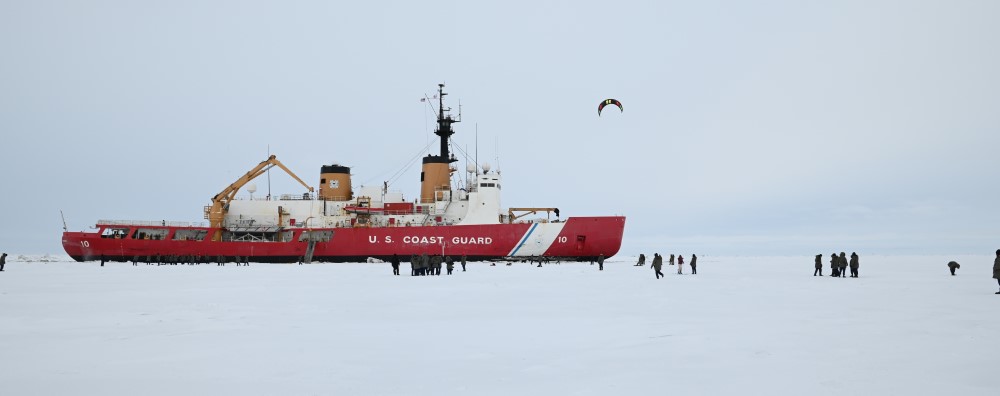
Crew members of USCGC Polar Star (WAGB 10) enjoys brief ice liberty on the frozen Bering Sea in below freezing temperatures on Jan. 30, 2021. (Photo by PO1 Cynthia Oldham/Coast Guard)
Coast Guard
The Coast Guard is the lead federal agency for homeland security, safety, and environmental stewardship in the Arctic, but it does so with thinly stretched resources. While the service’s large national security cutters were designed to maintain a year-round presence in the Bering Sea, they are not ice-capable ships.
There are only two operational icebreakers: USCGC Polar Star (WAGB-10) and Healy (WAGB-20), both based in Seattle. The heavy icebreaker Polar Star dates from the 1970s and is maintained using spare parts from decommissioned sister ship Polar Sea (WAGB-11), and the ships are in dire need of replacement. Healy is a medium-sized ship, half icebreaker and half science research ship, not suitable for the kinds of missions carried out by larger ships, although it carried out a northwest passage in the summer and fall of 2021, leaving Seattle in July and reaching Boston in mid-October.
The service pins its Arctic hopes on the new polar security cutter, a large, advanced, $746 million ship set to begin construction at Halter Marine in Pascagoula, Miss. Early funding has also been issued for a second ship, and the plan is to build three, with deliveries in 2024, 2025, and 2027. A planned three-ship class of medium polar cutters is also in the works, but no funding is as yet forthcoming.
The Coast Guard supports search-and-rescue operations, EEZ patrols, and aids-to-navigation work from its primary base at Kodiak Island on the south coast of Alaska.
Coast Guard Arctic operations also suffer from a serious communications gap, a situation affecting all government organizations in the region. According to the service’s strategy document, the high latitudes suffer from poor propagation of radio signals, geomagnetic interference, scant landside infrastructure, and limited satellite coverage and bandwidth. Even cellphone coverage is limited.
Addressing the comms gap is an issue facing all federal agencies, including North American Aerospace Defense Command and U.S. Northern Command.
Army
As the service with primary responsibility for the defense of the homeland, the Army maintains ballistic missile defense systems in Alaska, but those strategic systems are not directly related to new challenges in the Arctic.
Under its new Arctic strategy released in January 2021, the Army is increasing the number of units training in the far north and broadening those exercises.
A primary goal of the new strategy is to regain experience in operating in the region’s harsh conditions. For example, the Army introduced its Arctic Warrior exercise in February 2021 in Alaska.
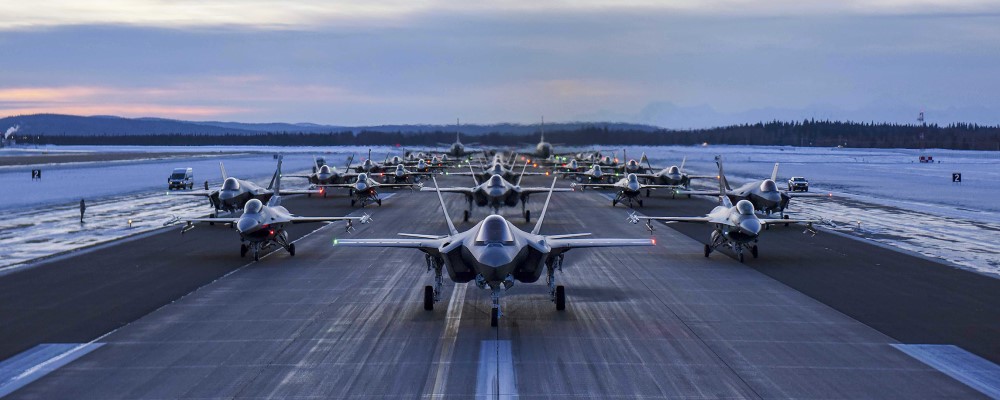
Aircraft of the Air Force’s 354th Fighter Wing and the Alaska Air National Guard’s 168th Wing line up at Eielson Air Force Base, Alaska. (Photo by Senior Airman Keith Holcomb/Air Force)
Air Force
The Air Force takes the lion’s share of the annual U.S. defense spending in the Arctic — a steady 80%.
Iris Ferguson, the Air Force’s top Arctic security expert who authored the service’s first Arctic strategy, ticked off some of the extensive activities in the far north.
“Our footprint is pretty heavy, but the missions are so large. A lot of the architecture for homeland defense comes from the Air Force,” Ferguson said.
Joint Base Elmendorf-Richardson in Alaska has F-22s, C-17s, C-130s, and the Rescue Coordination Center, she said. Eielson AFB has F-16s and F-35s.
“We’re also adding additional KC-135s to the fleet already there,” she said.
Also, Ferguson added, there are the huge training grounds at Joint Pacific Alaskan Range Complex (JPARC), the Space Situational Awareness assets at Clear Air Force Station, Alaska, and Thule Air Base in Greenland, and radar sites across Alaska and Canada through the North Warning System.
The Air Force also responds to incursions into the U.S. Air Defense Identification Zone (ADIZ), something the Russians have been regularly poking at. And Ferguson notes that as Russia further develops its Arctic regions, it is only natural to want to protect them.
“Russia is showing increasing investment in their coastline, rebuilding their infrastructure from the Cold War era. In some ways, it’s in their self-interest to protect the 25% of their gross domestic product that comes from the region,” she noted. “What gives us pause is the possibility that these defenses can become offensive in nature. Or when we see them creating potentially restrictive roles that are counter to international norms of freedom of air and sea movement. Those kinds of actions make us wonder what the real motivators are for developing the Arctic region.”
But Ferguson also cautioned not to look at the Arctic as a military competition.
“The media often tries to paint the Arctic region as a kind of zero-sum game, going into conflict. And at least right now it’s not really that kind of region, and we certainly don’t want it to be that kind of region. The whole idea is to prevent conflict.
“Going to war in the Arctic would be terrible. It would be very hard,” Ferguson said. “Our posture there is deterrence. Trying to prevent conflict is most important for us.”
Christopher P. Cavas is a defense journalist in the Washington, D.C., area. He is on Twitter @cavasships.
Military Officer Magazine
Discover more interesting stories in MOAA's award-winning magazine.
